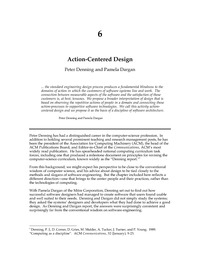Action Centered DesignPeter Denning, Pamela Dargan
Zu finden in: Bringing Design to Software, 1996
|
 |
 Diese Seite wurde seit 3 Jahren inhaltlich nicht mehr aktualisiert.
Unter Umständen ist sie nicht mehr aktuell.
Diese Seite wurde seit 3 Jahren inhaltlich nicht mehr aktualisiert.
Unter Umständen ist sie nicht mehr aktuell.
 Zusammenfassungen
Zusammenfassungen
 The software landscape is a mixed field of successes and failures. Along with
notably successful software packages for every task from payroll to party
invitations, we find notable failures, some of them spectacular. As one measure,
a 1979 US Government Accounting Office review of nine software projects for
the Department of Defense showed that about 2 percent of the allocated funds
were spent on software that was delivered and in use, about 25 percent were
spent on software that was never delivered, and about 50 percent were spent on
software that was delivered, but was never used (Neumann, 1995). This example
may represent an extreme case, but everyone in the software industry knows
that such problems are widespread and are of large magnitude. Software
engineering---a discipline of designed invented in the 1960s to address the
“software crisis”---has unwittingly created an illusion that a rigorous process of
transforming requirements into systems is the key to reliable design. With this
illusion comes a false sense of security that the solution to the crisis is at hand---
and that we will obtain it faster by throwing more research collars at the
problem.
The software landscape is a mixed field of successes and failures. Along with
notably successful software packages for every task from payroll to party
invitations, we find notable failures, some of them spectacular. As one measure,
a 1979 US Government Accounting Office review of nine software projects for
the Department of Defense showed that about 2 percent of the allocated funds
were spent on software that was delivered and in use, about 25 percent were
spent on software that was never delivered, and about 50 percent were spent on
software that was delivered, but was never used (Neumann, 1995). This example
may represent an extreme case, but everyone in the software industry knows
that such problems are widespread and are of large magnitude. Software
engineering---a discipline of designed invented in the 1960s to address the
“software crisis”---has unwittingly created an illusion that a rigorous process of
transforming requirements into systems is the key to reliable design. With this
illusion comes a false sense of security that the solution to the crisis is at hand---
and that we will obtain it faster by throwing more research collars at the
problem.We believe that the shortcoming is not due to a lack of effort or intelligence among software practitioners. We believe that the problem is of a different kind -- that the standard engineering design process produces a fundamental blindness to the domains of action in which the customers of software systems live and work. The connection between measurable aspects of the software and the satisfaction of those customers is, at best, tenuous. We propose a broader interpretation of design that is based on observing the repetitive actions of people in a domain and connecting those action-processes to supportive software technologies. We call this activity action-centered design and we propose it as the basis of a discipline of software architecture.
 Dieser Text erwähnt ...
Dieser Text erwähnt ...
 Tagcloud
Tagcloud
 Zitationsgraph
Zitationsgraph
 Zitationsgraph (Beta-Test mit vis.js)
Zitationsgraph (Beta-Test mit vis.js)
 Volltext dieses Dokuments
Volltext dieses Dokuments
 |  Action Centered Design: Artikel als Volltext ( Action Centered Design: Artikel als Volltext ( : :  , 130 kByte; , 130 kByte;  : :  Link unterbrochen? Letzte Überprüfung: 2020-11-28 Letzte erfolgreiche Überprüfung: 2015-02-28) Link unterbrochen? Letzte Überprüfung: 2020-11-28 Letzte erfolgreiche Überprüfung: 2015-02-28) |
 Anderswo suchen
Anderswo suchen 
 Beat und dieser Text
Beat und dieser Text
Beat war Co-Leiter des ICT-Kompetenzzentrums TOP während er Dieser Text ins Biblionetz aufgenommen hat. Die bisher letzte Bearbeitung erfolgte während seiner Zeit am Institut für Medien und Schule. Beat besitzt kein physisches, aber ein digitales Exemplar. Eine digitale Version ist auf dem Internet verfügbar (s.o.). Es gibt bisher nur wenige Objekte im Biblionetz, die dieses Werk zitieren.









 Software
Software Wasserfallmodell
Wasserfallmodell


 (
(

 Biblionetz-History
Biblionetz-History